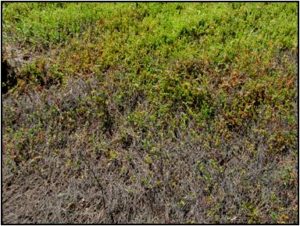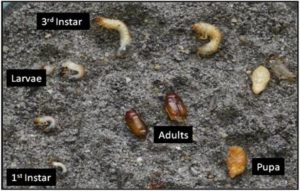If needed, post-pollination sprays (particularly for Sparganothis fruitworm and spotted fireworm) should be applied as soon as bees are removed; ideally before 11 July. Sparganothis fruitworm is monitored with pheromone traps to assess adult flight pattern and their abundance. If you had high trap counts of this pest and have not used an insecticide treatment yet you should consider treating soon to prevent damage to berries. Your post-pollination options include Diazinon, Exirel, Altacor, or Delegate.
Root-feeding insects and use of Imidacloprid
If your cranberry beds have damage caused by root feeding insects, you should consider treatment with imidacloprid (Admire Pro and other generics) immediately after bees are removed (mid-July). Dead plant patches indicate the presence of root-feeding insects (Figure 1). Pull dead vines and search through the root zone and soil for grubs. Imidacloprid is labeled for the control of rootworm, root grub (Phyllophaga spp.) (Figure 2), and other scarabs in cranberries. This insecticide is a contact and stomach poison that affects the insect nervous system. It is highly systemic and toxic to honey bees; therefore, can be used only as a post-pollination insecticide. This insecticide can be applied by ground or by chemigation. Aerial application of this product is prohibited. Admire Pro has a long residual activity (> 100 days) as long as the insecticide is not directly exposed to the sun and can be used at 7-14 fl oz/acre. A maximum of 14 fl oz of Admire Pro can be used per acre per season. Irrigate target area with 0.1 to 0.3 inches before and after the application of imidacloprid. The pre-harvest interval is 30 days. Most scarab grubs in cranberries have multi-year life cycles; consequently, you may not be able to suppress a population of 2- and 3-year life cycle grubs with a single application. You may have to use imidacloprid two to three years in a row for most effective suppression. For this reason, it is useful to know what species you have before using imidacloprid. See “Cranberry Insects of the Northeast” (authors: Averill and Sylvia) for information on how to identify common grub species in cranberries.

Figure 1. Damage caused by Phyllophaga grubs

Figure 2. Phyllophaga grubs

